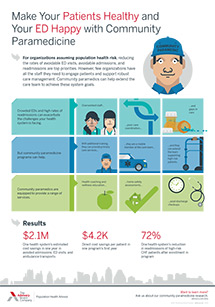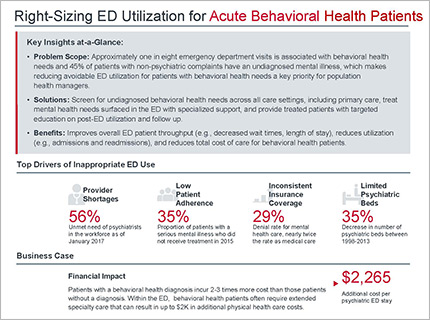Auto logout in seconds.
Continue LogoutBefore deploying to the battlefield, newly enlisted Navy medics are getting hands-on trauma care training at Stroger Hospital—a Chicago hospital that sees a significant number of traumatic firearm wounds, Shibani Mahtani repots for the Wall Street Journal.
How to implement Medicare's Chronic Care Management (CCM) codes
Trauma care at Stroger
While Chicago has seen a steady drop in murders since 2016, the city continues to experience an above-average number of gunshot victims, including those with "penetrating, life-threatening wounds akin to those on the battlefield," Mahtani writes.
Many of those patients are cared for at Stroger, which treats more than 6,000 patients annually. Roughly 30% of patients are admitted to Stroger with firearms wounds, while the national average for level 1 trauma centers is just 4.2%, according to the National Trauma Data Bank.

Make your patients healthy and your ED happy with community paramedicine
Faran Bokhari, who chairs the trauma and burn surgery unit at the hospital, said, "The experience here can't be replicated elsewhere, unless you have a major land invasion."
Stroger partners with Navy on pilot program
The Navy in 2014 launched a pilot program under which it embeds newly enlisted corpsmen at Stroger for six to eight weeks to get real-world trauma experience before deploying. The pilot is also open to those looking to sharpen their skills.
Navy medics, also known as hospital corpsmen, typically work independently in combat zones providing immediate medical care for wounds from gunshots, explosives, or shrapnel for many front-line Marine units. The medics usually undergo 14 weeks of first aid and patient care training after boot camp. They can choose to receive additional training.
Before the pilot program existed, according to Captain Paul Roach, a U.S. Navy surgeon at the Lovell Federal Health Care Center north of Chicago, "the first time a corpsman got any trauma experience was when they were deployed, and some would just freeze up."
But at Stroger corpsmen become familiar with protocol and replicate it when they're working independently in combat zones, Mahtani reports. For instance, they learn basic skills such as scrubbing in before entering an OR and how to use medical equipment, such as suction machines for patients who are losing blood. After two days of training, the corpsmen "are fully immersed in the trauma unit's team," Mahtani writes. The corpsmen are called on to help on the unit's busiest shift, which goes from 3 p.m. to 3 a.m.
An expanded partnership
To better prepare corpsmen for the battlefield, the Navy is working to formalize and expand the pilot to become an official training rotation this spring.
Department of Defense spokesperson Maj. Carla Gleason, said, "Corpsmen are not routinely exposed to trauma or critically injured patients during their first assignments." She added this "realistic, hands-on trauma training will allow them to hone their skills and increase their readiness" (Mahtani, Wall Street Journal, 3/14).
Next, get primers for reducing avoidable ED utilization
Are specific patient populations making up a significant proportion of your ED visits? Each installment in our Right-Sizing ED Use primer series takes a lens to one of these frequent user subgroups.
We analyze the reasons these patients seek care in the ED, the business case for intervening, and solutions for reducing unnecessary ED use. The primers also feature in-depth case studies which highlight the operational details of successful and targeted programs from leading health care organizations.
Don't miss out on the latest Advisory Board insights
Create your free account to access 1 resource, including the latest research and webinars.
Want access without creating an account?
You have 1 free members-only resource remaining this month.
1 free members-only resources remaining
1 free members-only resources remaining
You've reached your limit of free insights
Become a member to access all of Advisory Board's resources, events, and experts
Never miss out on the latest innovative health care content tailored to you.
Benefits include:
You've reached your limit of free insights
Become a member to access all of Advisory Board's resources, events, and experts
Never miss out on the latest innovative health care content tailored to you.
Benefits include:
This content is available through your Curated Research partnership with Advisory Board. Click on ‘view this resource’ to read the full piece
Email ask@advisory.com to learn more
Click on ‘Become a Member’ to learn about the benefits of a Full-Access partnership with Advisory Board
Never miss out on the latest innovative health care content tailored to you.
Benefits Include:
This is for members only. Learn more.
Click on ‘Become a Member’ to learn about the benefits of a Full-Access partnership with Advisory Board
Never miss out on the latest innovative health care content tailored to you.

